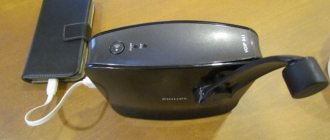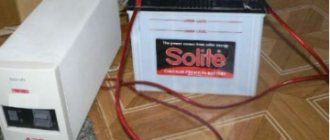Using sunlight to charge batteries has long ceased to be a subject for science fiction books and is effectively used in the modern world. Using a solar charger, you can easily charge MP3 players, laptops, cell phones and smartphones, which can be very useful in situations of sudden power outages or being away from electrical sources.
The solar charger is very easy to use: just place it in direct sunlight and connect the gadget and the portable device will charge.
Principle of operation
Its operating principle is quite simple: sunlight falls on a special panel, which absorbs it, after which the energy is processed by the device into electric current and supplied to the built-in power source.
Such devices have a number of advantages: they are silent, environmentally friendly, durable, do not require fuel and generate electricity for free.
Varieties
If you decide to buy an external solar charger, you should first decide where you plan to use it.
It could be:
- Charging mobile phones , smartphones and other handheld devices. To recharge your phone in case of force majeure, the smallest charger will be enough for you, but if you want to use all the capabilities of your mobile devices away from civilization, then you should choose a charger with a higher battery capacity.
- Charging laptops or tablets. For tablets with an output voltage of 5 V, almost any device is also suitable, but with power-hungry laptops it is more difficult - when buying a charger, you need to make sure that the output voltage is not lower than the voltage of your laptop. At the same time, charging will be able to restore the energy of a smartphone, camera, etc.
- Chargers for summer cottages and campsites. The most powerful of chargers with built-in AC outlets that can power household or medical equipment.
Chargers are also available with and without a battery. If you have a battery, the converted solar energy charges it, after which it charges your gadgets. In its absence, the sun's rays, being transformed, directly charge the equipment.
Simple option
Solder the solar battery wire to the voltage converter and charging is ready. To prevent the board from dangling, you can place it in some kind of box, glue it to a small cardboard, or turn it over with the other side facing the battery.
The design of such a battery depends only on the taste of the owner. In fact, the main thing for such a device is its convenience and functionality. But such a simple method of making a battery has many disadvantages: the device will discharge on its own. And the absence of an external battery will deprive the gadget of the ability to replenish its charge. Therefore, there is a more complex version of a homemade device.
Criterias of choice
So, you need a solar charger - how to choose the best option in terms of price and quality?
To do this you need to follow simple instructions:
- Study the technical specifications of the charger and compare them with the parameters of the gadgets you are going to charge.
- Check the compatibility of the charger connectors and the connected devices, as well as the presence of additional plugs and adapters.
- Explore additional features and choose the ones that suit you. Many models are equipped with a built-in flashlight; devices with Bluetooth function and even a radio receiver are available.
- Enjoy the compact design, weight and ease of use and portability.
- Decide on the appearance and design of the device. There are also various options for charging based on the operation of solar batteries: in a rigid case, flexible, shockproof, waterproof, as well as devices with a buffer battery.
- Choose the one that suits your price. It is worth considering that the main pricing factor is the power of the device.
Assembly Description
Assembling a charger for any type of smartphone strictly according to the diagram. In our case, the following scheme will be used.
Assembly diagram
Here is a complete assembly diagram for one future charging unit. In this situation, it is possible to parallel the panels to use them as one block. Note! There are dotted lines on the diagram along which the second panel should be connected to a single stabilization unit. The circuit is assembled on a body, which can be wooden boards, knocked together like a chessboard or other structures of a similar structure.
Important points of use
When using a solar charger, there are a few things you should know to help you get the most out of your device and extend its life.
The performance of a solar battery can be affected by factors such as:
- Panel area. With a larger area of energy, more energy is generated.
- Cell type. Polysilicon and monocrystalline elements have the highest performance.
- Cloudy conditions increase the time it takes for the battery to accumulate energy.
- If the panel is not positioned correctly in relation to the sun, this can also significantly reduce the speed. You can choose the most favorable location for the panel using a miniature light intensity indicator; in its absence, the general rule applies: a vertical panel location is better than a horizontal one.
- To constantly recharge the device you need, you can attach the charger to your backpack. But do not forget that it will only work in direct sun in open areas - it will be of no use in the forest.
- The charging time of the connected gadget is determined by the power output of the battery.
- Charging time using a photocell is shorter than when using conventional charging from the electrical network.
- When using a charger based on solar panels, you should control the temperature: it is not advisable to overheat it - on a too hot day, it is advisable to periodically remove the charger in the shade. Also, too high (or low) a temperature level can significantly reduce the battery capacity.
- During storage, it is advisable to recharge the battery from time to time to avoid increasing the static discharge coefficient.
- Before you start using the charger, it is recommended to carry out a training cycle 2-3 times (fully charge - completely discharge).
Charging batteries using solar panels
Grigorov Igor Nikolaevich, PO Box 68, 308015, Belgorod RUSSIArk3zk (at)antennex.comTo ensure operation of radio expeditions, nickel-cadmium batteries (NKB) are often used. But, over the course of time on air, the satellite needs to be recharged. In conditions of expeditionary work, one of the best options for recharging batteries is the use of solar panels. The energy of the sun will be quite capable of powering the batteries. Let's look at the principles of using solar panels to charge batteries.
Solar cell type
The most common solar panels in the CIS countries are BSK-1, BSK-2, Elektronika MCh/1. These batteries are produced or were previously produced by many radio-electronic factories. Sometimes there are also imported, mainly Chinese and Korean, solar batteries on sale, with parameters comparable to batteries of the BSK-1, BSK-2, Elektronika MCh/1 types.
These solar panels can provide battery charging current in the range of 35-50 milliamps, no more. Moreover, this will be in good sunlight. Consequently, with the help of widely used solar panels, it is possible to charge low-power batteries with a capacity of no more than 0.45 A/h. I note that the widely used TsNK-0.45 type batteries have exactly this capacity...
It is also necessary to take into account that in the middle of summer, in July, the light period during which the battery effectively releases energy usually lasts no more than 7-9 hours. The most efficient time for solar battery operation is from 10 a.m. to 5 p.m. After this time, the solar battery current drops. The current generated by the solar battery drops in cloudy weather. Some orientation of solar panels relative to the position of the Sun helps to increase the current they generate, but... Try to twist the batteries yourself in search of their best illumination, and see that this is not an easy task.
What can be done to increase the current generated by a solar battery?
The easiest way to increase the current of solar panels is by connecting them in parallel. Of course, it is necessary to include solar cells that have the same number of cells and, therefore, provide the same photoEMF voltage. But still parallel connection of solar panels, as shown in Fig. 1, undesirable. The best results will be obtained by connecting solar cell elements in parallel, as shown in Fig. 2. Figure 1 Undesirable connection of solar panels Figure 2 Parallel connection of solar cell elements
Let's look at why the parallel connection of solar panels shown in Fig. 2 is undesirable. 1.
Due to the different illumination of solar panels, the voltages generated by them will be slightly different from each other. As a result, only one solar battery will work effectively. When the solar cells are turned on according to the diagram shown in Fig. 2, the voltages generated by them are more evenly distributed throughout the solar battery. As a result, partial shading of some elements will not cause much harm to the operation of the solar battery. However, parallel connection will require unsoldering the finished batteries, and then reconnecting their elements to each other. The work is quite tedious, a braid of wires between the batteries... But if a large current is needed, then this work will still have to be done.
To increase the voltage of the solar battery, you can connect in series as many solar cells as you like. The voltage of such a solar battery will be equal to the sum of the voltages on all its constituent solar cells. The current supplied by this battery will be limited by the current of the inferior cell.
The main drawback of solar cells, in my opinion, is their relative high cost. But this drawback is compensated by the efficient operation of solar-charged batteries.
Charging/recharging batteries
So, with a sufficient number of solar cells, you can create a solar battery with almost any voltage and current, and capable of charging any type of battery. It's all about the cost of such a solar battery. Of course, we should not forget that a powerful solar battery will occupy a large area for its installation. It should also be noted that if full solar illumination of the battery occurs for a limited time of day, then it is advisable to use a solar battery that provides an accelerated charging current, the value of which is within 0.15-0.3 of the battery capacity.
Typically, on radio expeditions, effective work is possible in the evening and at night. At this time, coverage on many bands improves, and many local stations appear. Using a solar battery allows you to discharge the batteries in the evening and at night while working on the air, and recharge them during the day.
If the solar battery provides a current less than the rated charging current, less than 0.08 of the battery capacity, then in this case we may not be talking about charging, but only about recharging the batteries.
This means that during daylight hours the solar panel must be constantly connected to the battery, constantly recharging it all the time. In this case, it is necessary to control that during battery operation the voltage on one battery cell is not lower than 1.2-1.15 volts. If the voltage is below 1.15 volts, the battery must be removed from service and charged. Otherwise, in a short time, the voltage on the battery cells will drop to 1.1 volts, and such a discharged battery will no longer be able to be used on an expedition without serious charging. This indicates that during an expedition, it is imperative to monitor the voltage on the battery under load. The discharge and charging characteristics of a single battery are shown in Fig. 3. Figure 3 Discharge and charging characteristics of a nickel/cadmium battery
To further understand the process of charging a battery with a solar battery, let us consider the characteristics of the solar battery element.
The dependence of the current of one element of a solar battery of type BSK-2 on the voltage across it is shown in Fig. 4. This graph was taken with optimal illumination of the solar cell. This graph is typical for other solar cells. Of course, the maximum current value will depend on the power of the solar cell. To take this graph, a variable resistor is connected to the illuminated solar cell. Change the resistance of the variable resistor, and measure the current flowing into the resistor and the voltage across the solar cell. The circuit for reading the volt/ampere characteristics of a solar cell is shown in Fig. 5. Figure 4 Volt/ampere characteristic of a solar cell Figure 5 Circuit for reading the volt/ampere characteristics of a solar cell
When the solar cell is operating without a load, the photo EMF voltage on it will be about 0.6 V. When connecting a load, and then reducing its resistance, the load current will begin to increase. The voltage across the load will begin to decrease. A voltage of approximately 0.45 volts across the load is the optimal operating mode for the solar cell. When trying to increase the current draw, the voltage on the solar cell drops, but the current it generates continues to remain virtually unchanged. This suggests that the solar battery is an almost ideal source of current, which is exactly what is needed to charge batteries!
For the solar cell current measurement circuit (see Fig. 5), a graph of the power dissipation versus the solar cell load resistance was plotted.
The graph is shown in Fig. 6. This graph was taken with optimal illumination of the solar cell. To construct the graph, the load resistance of the solar cell was measured at various voltages across it. Then, based on the load resistance value and the current flowing through the load, a graph of the power dissipated in the load was plotted. From this graph it can be seen that the maximum power supplied to the load by the solar cell will be at a load voltage of 0.45 volts. The optimal load voltage (0.45 volts) differs from the photo-EMF voltage (about.6 volts) by 0.75 times. Figure 6 Graph of the dependence of power dissipation in the load resistance on the voltage across it.
Therefore, to charge the batteries, you can use a solar battery, which has a maximum generated current approximately equal to the battery charging current.
In this case, the solar battery will automatically charge the batteries with the required charging current when illuminated. The battery must be connected to the batteries via a diode, as shown in Fig. 7. This is necessary because in unfavorable sunlight, the voltage on the solar panel may drop lower than the voltage on the batteries being charged. In this case, the batteries, instead of being charged, will be discharged through the internal resistance of the solar battery. Buffer capacitor C1 is necessary if the batteries will be used for operation while being charged/recharged. Figure 7 Connecting a solar battery to batteries
A milliammeter is connected in series with the solar battery. The inclusion of a milliammeter is very, very desirable. It shows how much current the battery consumes from the solar panel. And this makes it possible to judge whether the battery is under charging current or training current, and in general, whether the solar battery is currently working or not. It is convenient to use a recording indicator from an old tape recorder as a milliammeter.
The shunt for this recording indicator is also quite simple to make. On a resistor of type MLT-0.5 we wind 1 meter of wire of type PEL-0.1. We connect the shunt in parallel with the microammeter and measure what maximum current it can measure. Let's say it turns out to be 100 milliamps. And to charge the batteries, a solar battery with a maximum current of 40 milliamps is used. Therefore, it is convenient to have a maximum scale of 50 milliamps. To obtain such a maximum deflection current of the microammeter, the shunt resistance must be doubled. To do this, it is necessary to increase the length of the shunt wire to two meters. Similarly, practical adjustment of the shunt can be carried out for other milliammeter deflection currents.
In field conditions, the battery charging process can be considered complete if the voltage on its elements under load is at least 1.25 V/per cell, and their EMF is at least 1.36 V/per cell. If the solar battery is used only to recharge the batteries, then it must be done as needed - as the batteries are discharged. Under unfavorable conditions, recharging can even last throughout the day. At night, there is no need to disconnect the solar panels from the batteries, since they will be turned off automatically using the VD1 diode (see Fig. 7).
Calculation of solar battery parameters
Let's give an example of calculating the solar battery required to charge the batteries. As shown in the graphs in Fig. 3, while charging the battery, the voltage on it will be within 1.4 V. To power equipment in the field, a supply voltage of 12 volts is usually used. This voltage can be provided by 10 nickel-cadmium batteries connected in series. To charge a battery of 10 nickel-cadmium batteries connected in series, it is necessary to provide a voltage across them equal to 14 volts (10 * 1.4 = 14). At the maximum efficiency of the solar battery, when the voltage on one solar cell is 0.45 volts, a voltage of 14 volts can be provided by a solar battery consisting of 31 elements (14/0.45=31).
Let's take into account the voltage drop across the diode, equal to 0.7 volts. Therefore, the solar battery must have two extra cells. The total number of solar cells in the battery in this case will be 33 (31+2=33). The photo EMF voltage of a solar battery containing 33 elements will be 19.8 volts. So we come to the important thing. It turns out that to charge a battery with a voltage of 12 volts, you need a solar battery with a photo emf voltage of almost 20 volts! Such a battery can be assembled independently using individual solar cells or several ready-made solar cells.
In the passport for solar batteries, the photo EMF voltage is indicated. Solar batteries are available for sale with photo EMF voltages of 12 and 9 volts. Therefore, with optimal load resistance (see Fig. 6), the voltage on these batteries will be 6.75 volts for a 9-volt solar battery, 9 volts for a 12-volt solar battery.
Two series-connected solar batteries having photo-EMF voltages of 9 and 12 volts can be successfully used to charge a 12-volt battery. Exceeding the total voltage, which for two batteries will be 21 volts, the calculated voltage of 20 volts by one volt is not scary. This excess will be compensated by a slight decrease in the output voltage of the solar battery, which will occur due to uneven illumination of the elements that make up the solar battery. Of course, we should not forget that the current of solar panels should not exceed the charging current of batteries.
Two 9-volt solar panels connected in series will not be able to fully charge the battery. They will only recharge it, to a level of no more than 20% of the required charge (see Fig. 3). However, a solar battery with a photo EMF of 18 volts connected to a 12 volt battery will help to “unload” the operating mode of this battery. It will be able to smooth out peak current loads and provide battery recharging to the best of its ability.
Operation of solar panels
When using solar panels, you must strive to ensure that they are placed in the most illuminated area and are equally illuminated. It is necessary to take measures to prevent mechanical damage to batteries, as well as direct exposure to moisture and dust. When transporting, avoid shaking the solar panels.
It is necessary to observe the temperature regime of solar panels, which is indicated in their passport. Usually this is -40° +50° C. In summer, in hot weather, it is necessary to place solar panels on a surface that is not subject to heating, for example, on a piece of white cloth, or on shiny aluminum foil. In this case, they heat up slightly and ensure satisfactory operation of the solar battery located on top of them.
It should be noted that nickel-cadmium batteries also perform poorly at high and low temperatures. Lowering the battery temperature below 0° C leads to a significant decrease in their power.
Solar panel test results
Practical tests of solar panels together with rechargeable batteries have shown the great efficiency of such joint work.
In practice, I have used several sets of solar panels. One set provided a photo EMF voltage of 18 volts. It was composed of two solar panels with a voltage of 9 volts. Later I managed to purchase a 12 volt solar battery. As a result of this, it became possible to use a set of solar panels with a voltage of 21 volts. These solar panels provided a load current of 40 milliamps.
At first, experiments were carried out in conjunction with a solar battery having a photoEMF voltage of 18 volts. The solar battery was constantly connected to the batteries according to the diagram shown in Fig. 7. A solar battery with a voltage of 18 volts ensured successful recharging of the battery using TsNK-0.45 and 1.5-NKGN elements. Unfortunately, only recharging. Such a solar battery could no longer charge the batteries, which were intensively discharged during night work. As a result, the batteries only worked for a short time the next night.
However, with the low load currents of these batteries, such a solar battery was quite useful. During the light period, it provided constant recharging of the batteries and kept them under training current, which had a beneficial effect on the operation of the batteries. As a result, the batteries worked much longer together with the solar battery than without it.
But the picture was completely different when using a solar battery with a voltage of 21 volts, which was composed of a battery with a voltage of 9 and 12 volts. This solar battery made it possible to charge the batteries during daylight hours. Moreover, this charge was quite enough for intensive evening operation of the transceiver with a power of 1 watt. Of course, such a solar battery should be considered optimal only for charging batteries of the TsNK-0.45 type, which have a charging current of 45 milliamps. Such a battery could not fully charge batteries of the 1.5 NKGN type, which have a charging current of 150 milliamps. But at the same time, it will significantly increase the capacity wasted during dark hours!
The 21 volt battery can be connected to 1.5 NKGN type batteries operating during the day. It is not advisable to connect it to TsNK-0.45 type batteries operating in conjunction with radio equipment. In this case, this type of battery will work in a difficult mode for them, which can cause their accelerated failure. To avoid this, it is advisable to use two batteries during an expedition, one for operation, and the other for charging at this time.
Attention: overcharging is possible!
It is necessary to draw the attention of the radio amateur that in some cases the solar battery can overcharge the battery. And this will lead to a reversal of the polarity of the battery cells and to its failure. We can immediately say that when using an 18-volt solar battery, there is no need to worry about overcharging the 12-volt battery. As we have already discussed, a solar battery with a voltage of 18 volts can only provide additional charging of the battery at the level of 20% of its rated power. After this, the solar panel will only provide training current to these batteries.
A completely different case will be when using a solar battery with a voltage of 21 volts. This battery is capable of providing charging current even after the batteries are fully charged. It should be immediately noted that when using a solar battery providing a charging current of 40 milliamps, only batteries of the TsNK-0.45 type can be damaged. Batteries of the 1.5-NKGN type, which require a charging current of 150 milliamps, are difficult to spoil with such a solar battery during the expedition. But you still need to be careful when charging them.
In order not to damage the battery, it is necessary to keep track of its operating time. After this, recharge the given container. I will give an example of such a calculation. Let's take the simplest case. The rechargeable battery, composed of TsNK-0.45 elements (hence, has a charging current of 40 milliamps), powers the receiver with a consumption current of 40 milliamps. Let's assume this receiver worked for 4 hours in the evening. Therefore, the lost battery capacity is 160 mA/hour (40*4=160). To restore the lost capacity of the battery, it must receive a charge 150% greater than the lost charge. Therefore, to restore charge, this battery must be under a charging current of 40 milliamps for 6 hours during the day (160/40=4; 4*1.5=6).
What if the battery was used to power a transceiver that transmits? Well, it is necessary to take into account the time during which it works for transmission. Let's say the transceiver consumes 50 milliamps during reception and 150 milliamps during transmission. The transceiver worked for 3 hours, including half an hour for transmission. Consequently, the battery supplied a current of 50 milliamps for 2.5 hours and 150 milliamps for 0.5 hours. Let's calculate the lost capacity:
- while taking 125mA/hour (50*2.5=125);
- during transmission 75mA/hour (150*0.5=75);
- the total lost capacity is 200mA/hour (125+75=200).
To restore the lost capacity of the battery, it must receive a charge 150% greater than the lost charge. Therefore, to restore charge, this battery must be under a charging current of 40 milliamps during the day for 7.5 hours (200/40=5; 5*1.5=7.5).
Elimination of memory effect
Unfortunately, nickel-cadmium batteries have a so-called memory effect. How is it shown? If the battery is not completely discharged several times, say by 30% of its capacity, and then recharged again, the battery will “remember” the discharge cycle. Subsequently, the battery will only release 30% of its charge, even when fully charged. Usually on radio expeditions the batteries do not have time to catch this disease. The battery experiences different discharge/charge cycles every day, and the discharge cycles can be quite deep. However, after the end of the expedition in which the batteries were recharged, in order to eliminate the memory effect, the battery must be given at least two full discharge/charge cycles.
Good luck using the solar battery on radio expeditions!
The article was published by: Radioconstructor. - No. 10 - 2002, S. - 13 - 17.
How to make it yourself
Some prefer an alternative option, such as making a solar battery charger yourself, especially since it is not so difficult, expensive and interesting.
Tools
To make a solar battery charger with your own hands, you will need the following tools:
- tweezers;
- pliers;
- glue gun;
- blowtorch;
- knife.
Materials
Also prepare the following materials:
- 5V or greater solar panel;
- 3.7 V lithium-ion battery;
- battery charge monitoring circuit;
- DC boost circuit (USB);
- two 2.5 mm connectors – one with panel mounting, the second with a wire;
- diode 1N4001;
- the wire.
And auxiliary materials for the design: insulating tape, heat-shrinkable tubes (preferably), double-sided foam tape, solder, box (tin or any suitable one).
Stages of work
Having prepared everything you need, you can start making a solar battery charger with your own hands.
The manufacturing stages are as follows:
- Connecting the wire.
- Preparing holes for connectors in the housing.
- Connecting a charge controller.
- Connecting the battery and USB circuit.
- Careful insulation of wires.
- Placement of electronic components in the housing.
If you've made your own solar charger, you know that it can also be charged by sunlight or via a mini USB port. The LED should light up red during charging and blue when charging is complete.
Now you can not only choose the optimal charging option, but also know how to make a charger from a solar battery that will help you save electricity and not be left without communication and other conveniences of modern technology in extreme situations, or just on vacation.











